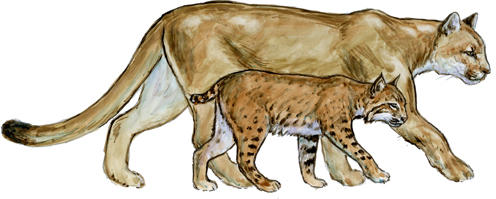Distribution and Abundance
Bobcats have been reported from almost every Indiana county but are most common in southern and west-central Indiana. A study conducted by the DNR in south-central Indiana revealed that bobcats are capable of dispersing up to 100 miles from where they were born. The DNR collects reports of bobcat sightings, trail-camera photos, and mortalities. Bobcat reports are also collected through the annual Archer’s Index, in which volunteer deer bow hunters report the number of hours they hunted and the species they saw while hunting.
Bobcats prefer forested areas that have brushy areas, fields, or clear cuts that are beginning to regrow mixed in. Female bobcat home ranges may vary from 6–12 square miles, and male bobcat home ranges may vary from 30–75 square miles. Bobcats are primarily nocturnal, hunting and moving during early-morning and late-evening hours; however, seeing a bobcat during the day is not cause for concern.
Food Habits
Indiana research has documented bobcat diets to include:
- Rabbits
- Mice and voles
- Squirrels
- White-tailed deer, especially fawns
- Muskrats
- Waterfowl and songbirds
Indiana research did not document wild turkey consumption by bobcats, though bobcats would eat a wild turkey if they manage to catch one. Wild turkey does not seem to be a common prey item for Indiana bobcats.
Reproduction
Bobcats are territorial and generally solitary animals. While bobcats can breed year-round, the vast majority of mating generally occurs in early spring during February and March with the young being born after a 62-day gestation period. An average litter of 1–3 kittens is born in April or May. The female may move the kittens to several different dens during the growth period. Males do not assist in raising the young. The young generally remain with the female until they reach 1 year of age then disperse. Kitten survival is associated with prey abundance, with more young surviving during the years of higher rabbit and other small-mammal populations.
Viewing Tips
Bobcats are quiet, secretive and active at night. Seeing them in person is difficult. Most people who do see them do so by setting up trail cameras on travel corridors, whether it’s along waterways or natural trails through the woods. Occasionally, a bobcat may be spotted hunting for rabbits on a thick, brushy field edge or near a stream edge looking for food. Visitors who go to thick, brushy areas near open fields that are good spots to find rabbits or drive slowly along brush-lined roads like those at Potato Creek State Park, Sugar Ridge Fish & Wildlife Area or Greene-Sullivan State Forest may occasionally get lucky and spot a bobcat.
Management and Control
As with all wildlife, bobcats should be respected if encountered. The natural response of a bobcat is to move away from humans. Bobcats, like all wildlife, should never be fed or approached because doing so can reduce their natural response to avoid people and lead to negative interactions. Removing potential attractants that attract rodents, like pet food or bird feeders, can help encourage a bobcat that is hanging around a yard to move on.
Pets should always be leashed when outdoors or kept in a kennel with a secure top to prevent negative interactions with all wildlife, including bobcats. Conflicts between bobcats and livestock are uncommon but may occur. Most reports are of bobcat predation on chickens or ducks. Landowners or lessees may request a nuisance wild animal control permit from the DNR for bobcats if damage is occurring. Landowners or lessees may also hire a nuisance wildlife control operator to assist them if they are not comfortable removing the bobcat themselves. Bobcats causing conflict may not be removed without a permit.
Indiana initiated its first limited, regulated bobcat trapping season in 2025. The season is limited to certain counties and has both a bag limit and season quota. Learn more about the bobcat trapping season. Bobcats are monitored through surveys, and season limits are informed by a habitat-based population model developed in partnership with Purdue University researchers.



